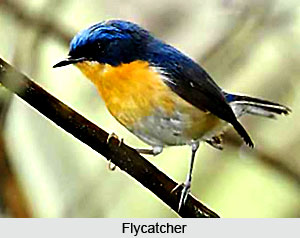 Flycatcher is a diverse group of small insectivorous passerine birds with compresses bill belonging to the family Muscicapidae. All Old World flycatchers are found in Europe, Asia, Africa and Australia up to New Zealand. The ecologically equivalent New World flycatchers of the family Tyrannidae have no taxonomical relationship with them. Forty species are found in the Indian subcontinent, including eight endemics and a few winter migrants from the Himalaya and beyond. The Pygmy Flycatcher (eight centimetres) is the smallest in size whereas the Paradise Flycatcher is the largest (twenty centimetres). They live in all habitata, though the majority are forest dwellers. The Red breasted Flycatcher (Muscicapa parva) is the commonest migratory species and in winter may frequently be found in gardens even in congested cities like Kolkata and Mumbai.
Flycatcher is a diverse group of small insectivorous passerine birds with compresses bill belonging to the family Muscicapidae. All Old World flycatchers are found in Europe, Asia, Africa and Australia up to New Zealand. The ecologically equivalent New World flycatchers of the family Tyrannidae have no taxonomical relationship with them. Forty species are found in the Indian subcontinent, including eight endemics and a few winter migrants from the Himalaya and beyond. The Pygmy Flycatcher (eight centimetres) is the smallest in size whereas the Paradise Flycatcher is the largest (twenty centimetres). They live in all habitata, though the majority are forest dwellers. The Red breasted Flycatcher (Muscicapa parva) is the commonest migratory species and in winter may frequently be found in gardens even in congested cities like Kolkata and Mumbai.
Most species of Flycatchers gather for food by aerial sallies or `fly catching`, some of them by flitting amongst the foliage or from the ground. A few flycatchers take small soft berries in addition to insects which are their staple diet. These birds do normally live in pairs; some are seen at times joining the mixed-species hunting flocks of insectivorous birds. Most of the flycatchers maintain a territory all the year round, while some maintain the territory mostly at the time of breeding season only. Some like the Black-and-Orange Flycatchers are highly parochial.
Breeding activities start around the Month of March when the males sing and perform courtship displays, spectacular in some species like the ribbon-tailed Paradise Flycatcher (Terpsiphone paradise). In many species the females alone build the nest; in others both sexes share all the breeding activities. The nests are normally placed on shrubby plants and trees; some in crevices or in banks of streams or under jutting rocks, etc. An open cup-shaped nest is the rule though some prefer holes or depressions in tree-trunks, rocks or walls of buildings. A few make globular nests with a side entrance. Much cobweb is usually employed in the open nests. The clutch-size varies between two and four eggs, exceptionally five or only one. Incubation and nest-feeding are either by the female alone or by both sexes equally.











